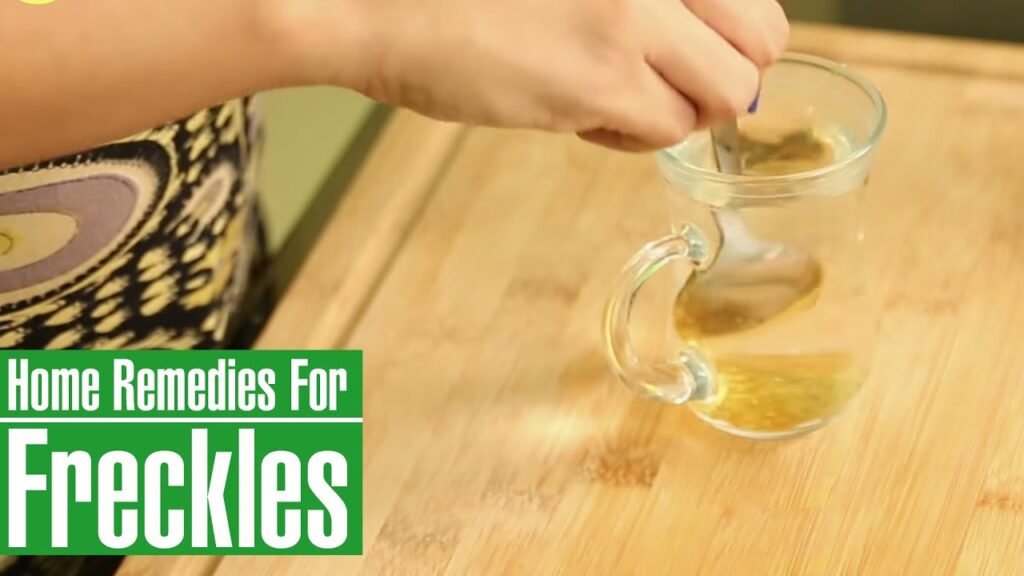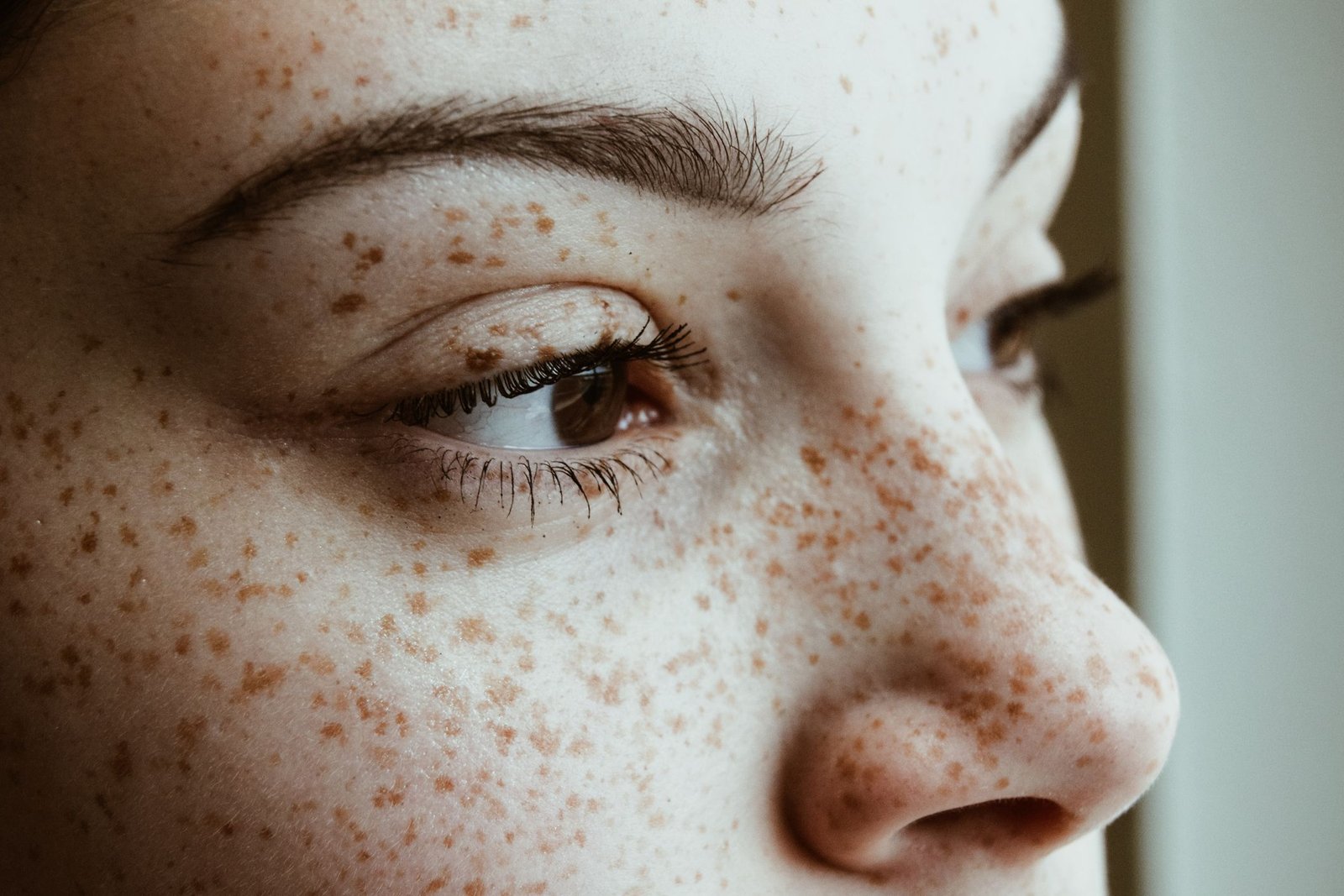
what is facial freckles
Facial freckles, also simply known as freckles, are small, flat, and pigmented spots that appear on the skin, particularly on the face. They are typically tan, light brown, or reddish in color and are more common in individuals with fair skin, although people of all skin types can have them. Freckles are caused by an increase in the production of melanin, the pigment responsible for the color of our skin, hair, and eyes.
The main factors contributing to the development of freckles include:
- Genetics: Freckles can be hereditary, meaning they tend to run in families. If your parents or grandparents have freckles, you’re more likely to have them too.
- Sun exposure: Exposure to ultraviolet (UV) rays from the sun is a significant factor in the development of freckles. Sunlight stimulates the melanocytes (cells that produce melanin) to release more melanin in response to UV radiation. This can lead to the formation of freckles, especially in people with fair skin who are more susceptible to sunburn.
Freckles are not harmful and are usually benign, but they can be a cosmetic concern for some people. They tend to darken with sun exposure and often fade or become less noticeable during the winter months when there is less sun exposure. Freckles are not a skin condition that requires treatment, but individuals who want to reduce their appearance may consider using sunscreen regularly, wearing protective clothing, or using cosmetic products to lighten them temporarily. If you have concerns about any skin changes or lesions, it’s advisable to consult a dermatologist for a proper evaluation.
Why facial freckles appear
Freckles appear on the skin primarily due to two main factors: genetics and sun exposure.
- Genetics: The tendency to develop freckles can be passed down through family genes. If your parents or grandparents had freckles, you are more likely to develop them as well. The genetic factor influences how many freckles you may have and where they are most likely to appear on your skin.
- Sun Exposure: Sunlight is a significant trigger for the formation and darkening of freckles. When your skin is exposed to ultraviolet (UV) radiation from the sun, it stimulates the melanocytes, which are specialized cells in the skin that produce melanin, the pigment responsible for the color of your skin, hair, and eyes. In response to UV rays, melanocytes produce more melanin, which can lead to the formation of freckles. Freckles act as a defense mechanism for the skin, as they provide some level of protection against UV radiation by absorbing and scattering the harmful rays.
It’s important to note that freckles are more common in individuals with fair or light skin, as they have less melanin overall to provide natural protection against UV damage. Freckles tend to darken when exposed to the sun and may become more prominent during the summer months. Over time, with continued sun exposure, freckles can become more permanent and may not fade entirely during the winter months.
While freckles are generally harmless, excessive sun exposure can lead to skin damage, including sunburn and an increased risk of skin cancer. Therefore, it’s essential to protect your skin from the sun by wearing sunscreen, protective clothing, and sunglasses, and by seeking shade when needed, especially if you are prone to freckles or have fair skin.
read Healthy Skin Care Tips: Achieving Radiant Skin Naturally
How to remove freckles permanently at home
It’s important to note that freckles are a natural feature of the skin, and they are not harmful. While there are various methods and home remedies that claim to lighten or reduce the appearance of freckles, it’s essential to approach freckle removal with caution, especially when attempting treatments at home. Completely removing freckles permanently at home is often challenging, and results can vary from person to person.
Here are some home remedies and methods that people may try to reduce the appearance of freckles, but please consult with a dermatologist before attempting any of these treatments:
- Lemon Juice: Lemon juice contains natural bleaching properties and can be applied to freckles. However, it can also be harsh on the skin and may cause irritation or sensitivity to sunlight. If you choose to use lemon juice, dilute it with water and apply it to the freckles for a short time (5-10 minutes), then rinse thoroughly and apply sunscreen.
- Aloe Vera: Aloe vera gel is known for its soothing properties. While it may not remove freckles, it can help with skin care and reduce redness or irritation caused by other treatments or sun exposure.
- Dairy Products: Some people use dairy products like milk or yogurt as a natural bleach for freckles. Apply a small amount to the freckles, leave it on for a short time, and rinse thoroughly.
- Vitamin C: Topical creams or serums containing vitamin C may help lighten freckles over time. Vitamin C is known for its skin-brightening properties and may also provide some protection against UV damage.
- Over-the-Counter (OTC) Lightening Products: There are OTC products containing ingredients like hydroquinone or glycolic acid that claim to lighten skin or reduce the appearance of freckles. However, these should be used with caution and under the guidance of a dermatologist, as they can have side effects and may not be suitable for all skin types.
- Sunscreen: Preventing further freckling and protecting your skin from the sun is crucial. Regularly applying a broad-spectrum sunscreen with SPF 30 or higher can help prevent freckles from darkening and protect your skin from UV damage.
If you’re serious about freckle removal, it’s best to consult with a dermatologist. They can assess your specific situation, recommend appropriate treatments, and provide guidance on professional procedures like laser therapy, chemical peels, or cryotherapy, which may be more effective for reducing the appearance of freckles. These procedures should only be performed by trained professionals in a clinical setting to minimize the risk of complications.
Best freckle removal treatment
best freckle removal treatment
The best freckle removal treatment depends on your individual preferences, skin type, and the severity of your freckles. It’s important to note that freckles are a natural feature of the skin, and complete removal may not be possible or desirable for everyone. However, there are several effective treatments that can help reduce the appearance of freckles:
- Topical Bleaching Agents: Dermatologists may prescribe topical creams or gels that contain ingredients such as hydroquinone, tretinoin, or glycolic acid. These products can help fade freckles over time by inhibiting melanin production. They are typically used under the guidance of a healthcare professional.
- Chemical Peels: Chemical peels involve applying a chemical solution to the skin, which causes the top layer to peel off. This can be effective in reducing the appearance of freckles and improving overall skin tone. Different types of peels are available, ranging from mild to deep, depending on the severity of the freckles.
- Laser Therapy: Laser treatments, such as intense pulsed light (IPL) therapy and fractional laser therapy, can target and break down melanin in freckles. This can lead to a significant reduction in freckle visibility. Laser therapy should be performed by a trained dermatologist or healthcare professional.
- Cryotherapy: Cryotherapy involves freezing the freckles with liquid nitrogen to remove them. This is a quick procedure that can be effective for some types of freckles, but it may cause temporary redness and scabbing.
- Microdermabrasion: This exfoliating procedure involves removing the top layer of skin with a special device. It can improve the appearance of freckles, but multiple sessions may be required for noticeable results.
- Prescription-Strength Skincare Products: Your dermatologist may recommend a combination of prescription-strength skincare products, including topical creams and sunscreen, to manage and prevent freckles.
- Sun Protection: Regardless of the treatment chosen, it is crucial to use sunscreen with a high SPF rating (30 or higher) daily and take other sun protection measures (wearing protective clothing, sunglasses, and seeking shade) to prevent freckles from darkening or reoccurring.
The best treatment for you will depend on factors such as the type and location of your freckles, your skin type, and your desired results. It’s essential to consult with a dermatologist or qualified healthcare professional to determine the most suitable treatment option and to discuss the potential risks and benefits. Additionally, some individuals choose to embrace their freckles, as they are a natural and unique aspect of their skin.
freckles removal cream
freckles removal cream
There are various freckle removal creams available over-the-counter (OTC) and by prescription that claim to help reduce the appearance of freckles. These creams often contain ingredients that inhibit melanin production or exfoliate the top layer of skin to fade freckles gradually. It’s important to note that the effectiveness of these products can vary from person to person, and results may take several weeks or even months to become noticeable. Here are some common ingredients found in freckle removal creams:
- Hydroquinone: This is a common skin-lightening agent found in many freckle removal creams. It works by inhibiting the production of melanin in the skin. Hydroquinone products are available both over-the-counter and by prescription in various strengths.
- Tretinoin (Retin-A): Tretinoin is a topical retinoid that can improve skin texture and may help fade freckles over time. It is available by prescription and should be used under the guidance of a dermatologist.
- Glycolic Acid: This alpha hydroxy acid (AHA) exfoliates the top layer of skin and can help fade freckles. It is often found in over-the-counter skincare products.
- Kojic Acid: Kojic acid is a natural skin-lightening agent derived from certain fungi. It is used in some freckle removal creams and may help reduce pigmentation.
- Vitamin C (Ascorbic Acid): Topical vitamin C serums may help brighten the skin and reduce the appearance of freckles. These products are available over-the-counter.
- Arbutin: Arbutin is a natural derivative of hydroquinone and is used in some skincare products for its skin-lightening properties.
- Licorice Extract: Licorice extract contains compounds that can help reduce pigmentation and may be found in freckle removal creams.
It’s important to use these products as directed and be patient, as it may take several weeks to see noticeable results. Additionally, it’s crucial to use sunscreen daily when using freckle removal creams, as your skin will be more sensitive to UV radiation, and sun exposure can worsen freckles.
If you’re considering using a freckle removal cream, especially one containing prescription-strength ingredients, it’s advisable to consult a dermatologist. They can assess your skin, recommend the most suitable product or treatment for your specific needs, and provide guidance on how to use it effectively and safely.
How to get rid of freckles naturally
How to get rid of freckles naturally
Freckles are a natural feature of the skin, and it’s important to note that complete and permanent removal of freckles through natural methods is challenging. Freckles are not harmful and do not require removal unless you have specific cosmetic concerns. However, there are natural methods that may help reduce the appearance of freckles over time. Keep in mind that the effectiveness of these methods can vary from person to person, and results may be subtle. Here are some natural approaches to consider:
- Sun Protection: One of the most effective ways to prevent freckles from darkening or appearing in the first place is to protect your skin from the sun. Freckles often become more pronounced with sun exposure. Follow these sun protection tips:
- Wear sunscreen with a high SPF rating (30 or higher) daily, even on cloudy days.
- Reapply sunscreen every two hours when outdoors.
- Wear protective clothing, including wide-brimmed hats, long-sleeved shirts, and sunglasses.
- Seek shade when the sun is strongest, typically between 10 a.m. and 4 p.m.
- Lemon Juice: Lemon juice contains natural bleaching properties due to its high vitamin C content. Some people use diluted lemon juice as a natural remedy to lighten freckles. Here’s how to use it:
- Mix fresh lemon juice with an equal amount of water.
- Apply the mixture to your freckles using a cotton ball.
- Leave it on for 10-15 minutes.
- Rinse thoroughly with water.
- Apply sunscreen afterward, as lemon juice can make your skin more sensitive to sunlight.
- Aloe Vera: Aloe vera gel is known for its soothing properties and can help reduce skin irritation caused by freckles or sun exposure. Apply aloe vera gel to the freckles regularly.
- Vitamin C: Topical vitamin C serums or creams may help brighten the skin and reduce the appearance of freckles. Look for products containing ascorbic acid or other vitamin C derivatives.
- Dairy Products: Some people use dairy products like milk or yogurt as natural bleaching agents. Apply a small amount to your freckles, leave it on for a short time, and rinse thoroughly.
- Licorice Extract: Licorice extract contains compounds that may help reduce pigmentation. You can find licorice extract in some natural skincare products.
- Cucumber: Cucumber slices or cucumber juice can be applied to the skin to soothe and refresh it. While not a direct freckle remover, it can improve overall skin health.
It’s important to note that natural remedies may take time to show results, and they may not completely remove freckles. Additionally, some individuals choose to embrace their freckles as a unique and natural aspect of their skin. If you have concerns about your freckles or are considering more aggressive methods of freckle removal, it’s advisable to consult with a dermatologist. They can provide personalized recommendations and discuss professional treatments that may be more effective in addressing your specific needs.
Summary
Facial freckles are small, flat, pigmented spots that appear on the skin, particularly on the face. They are typically tan, light brown, or reddish in color and are more common in individuals with fair skin. The main factors contributing to their appearance are genetics and sun exposure. Freckles can be hereditary, meaning they tend to run in families.
When the skin is exposed to ultraviolet (UV) rays from the sun, it stimulates the production of melanin, the pigment responsible for skin, hair, and eye color. This increased melanin production leads to the formation of freckles, especially in people with fair skin who are more susceptible to sunburn. While freckles are generally harmless and don’t require treatment, some individuals may use various methods, including skincare products, to reduce their appearance. For more significant or permanent removal, professional dermatological treatments such as laser therapy or chemical peels may be considered. It’s essential to protect the skin from the sun to prevent freckles from darkening and to reduce the risk of UV damage.
FAQs
Here are some frequently asked questions (FAQs) about facial freckles:
- What are facial freckles?
- Facial freckles are small, flat, pigmented spots that appear on the skin, particularly on the face. They are typically tan, light brown, or reddish in color.
- What causes facial freckles?
- The main causes of facial freckles are genetics and sun exposure. They can be hereditary, and sun exposure stimulates the production of melanin, leading to freckle formation.
- Are facial freckles harmful?
- No, facial freckles are generally harmless and not a sign of any underlying health condition. They are a natural feature of the skin.
- Can facial freckles be removed permanently?
- Complete and permanent removal of facial freckles can be challenging. Professional dermatological treatments such as laser therapy, chemical peels, or cryotherapy may help reduce their appearance, but they may not be completely removed.
- How can I reduce the appearance of facial freckles?
- You can reduce the appearance of facial freckles by using sun protection, such as sunscreen and protective clothing, avoiding excessive sun exposure, and using skincare products with ingredients like hydroquinone, glycolic acid, or vitamin C.
- Are there natural remedies for reducing facial freckles?
- Some natural remedies may help reduce the appearance of freckles, such as applying diluted lemon juice, aloe vera gel, or vitamin C serums. However, results may vary, and it’s essential to use them with caution.
- Are there any risks associated with freckle removal treatments?
- Some treatments, especially when done incorrectly, can cause side effects such as skin irritation, redness, or sensitivity to sunlight. It’s crucial to consult with a dermatologist before attempting any freckle removal treatments.
- Can I prevent facial freckles from appearing or darkening?
- Yes, you can prevent facial freckles from appearing or getting darker by using sunscreen with SPF 30 or higher daily, wearing protective clothing, and seeking shade when necessary.
- Do freckles fade or change over time?
- Freckles can change with sun exposure. They tend to darken during sun exposure and may fade or become less noticeable during the winter months.
- Should I be concerned if I notice a new or changing freckle on my face?
- While freckles are usually benign, if you notice a new or changing freckle, it’s advisable to consult a dermatologist, as it could be a sign of skin changes that require further evaluation.
Remember that individual experiences with facial freckles and their treatments can vary, so it’s essential to consult with a healthcare professional or dermatologist for personalized advice and guidance.
https://en.wikipedia.org/wiki/Freckle
also read Balanced Diet for Health | 9 Facts






